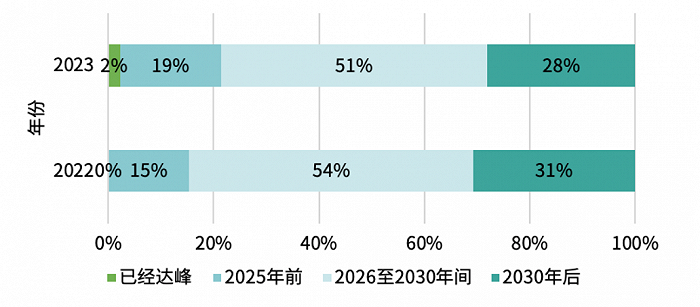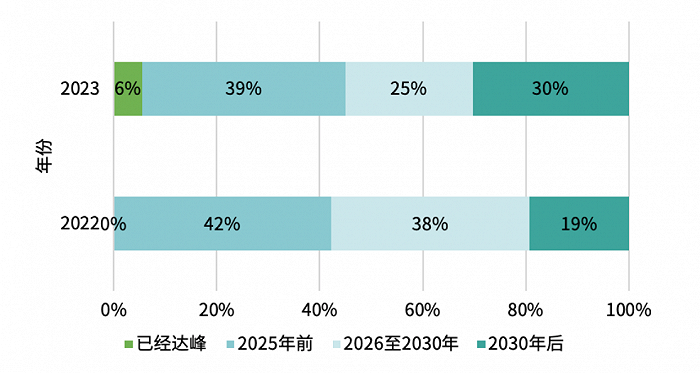The latest survey on the "dual carbon" goal: more than seventy percent of experts believe that China can achieve the goal of carbon peaking
What is the judgment of professionals on China's "dual carbon" process?
According to the latest survey, more than 70% of experts believe that China can achieve its goal of peaking carbon dioxide emissions before 2030, but more than half predict that China's carbon emissions will peak by more than 15% above 2020 levels.
On November 21, two international organizations, the Center for Energy and Clean Air Research (CREA) and the International Energy Transition Society (ISETS), jointly released the report "China's Climate Transition Outlook 2023: Expert Survey and Interviews" based on a questionnaire survey and interviews with 89 experts.
The survey subjects include 64 domestic experts and 25 foreign experts, whose professional fields are mainly energy, environment and sustainable development. In addition to scholars from universities and scientific research institutions, the survey also included practitioners from the government, state-owned enterprises, energy companies, non-governmental organizations and other units. CREA is a research institute based in Finland and ISETS is a not-for-profit organization based in Australia.
"Under the influence of multiple uncertainties such as the global economy and energy, China's climate action cannot be ignored. While we see more optimism among experts about China's carbon peaking by 2030, we must also be aware of the challenges of reducing peaking and achieving long-term carbon neutrality goals. CREA China Policy Analyst Qiu Chengcheng said in a press release.


Compared with last year's survey results, the experts surveyed this year are more positive about the timing of China's carbon peaking, according to the report.
As for the peak level, 56% of experts predict that China's carbon dioxide emissions will be more than 15% higher than in 2020 when it reaches its carbon peak, and 26% predict a 10%-15% increase from 2020.
According to the State Council, China's carbon intensity in 2020 was 18.8% lower than in 2015. According to the China Carbon Accounting Database (CEADs), hosted by Tsinghua University, China's total apparent carbon dioxide emissions in 2020 were 10.737 billion tons.
By sector, the forecasts of the experts surveyed are sharply divergent when it comes to the power sector, China's largest source of emissions.

According to the survey, 6% of experts believe that China's power sector has already peaked carbon emissions, 39% believe that it can peak before 2025, 25% support peaking between 2026 and 2030, and the remaining 30% believe that it will peak after 2030.
According to PwC's CEADs database, the power and heat sector is the most important source of emissions in China, accounting for 46.61% of China's total CO2 emissions in 2018.
Industry and transportation are the second and third largest sources of carbon emissions in China, accounting for 37.29% and 7.68% respectively in 2018.
The experts interviewed are more optimistic about the prospects for emission control in China's major industrial sectors, such as steel and cement.
According to the survey results, 76% of experts believe that China's steel industry will peak carbon emissions by 2030, and 20% of them believe that the steel industry will peak by 1-5 years. "These results suggest that some experts are more optimistic about the steel industry's emissions reduction outcomes and actual peak time," the report said.
For the cement industry, 76% of experts believe that carbon emissions will peak before 2030. Among them, about 21% of experts believe that carbon emissions from the cement industry have peaked.
In contrast, experts' predictions for the peak time of the transportation industry are later than those of other industries. However, some 37% of experts believe that carbon emissions from China's transport sector will peak before 2030, a significant increase from last year.

The report also examines the growth prospects for energy consumption such as coal.
In October 2021, the Central Committee of the Communist Party of China (CPC) and the State Council set targets for China's coal consumption in the "Opinions on Completely, Accurately and Comprehensively Implementing the New Development Concept and Doing a Good Job in Carbon Peak and Carbon Neutrality": "Strictly control the growth of coal consumption during the 14th Five-Year Plan period, and gradually reduce it during the 15th Five-Year Plan period". This also means that China's coal consumption should peak around 2025.
According to the survey, about one-third of experts believe that China's coal consumption can peak in 2025 as scheduled. However, compared with last year, the proportion of experts surveyed this year who are unsure about the peak time of coal consumption has increased significantly.
According to the report, all the experts interviewed made it clear that the peak of coal consumption needs to take into account the correlation between the energy transition and the global and domestic economic situation. In addition, the importance of energy security cannot be overlooked.
"The findings may reflect the uncertainty that has been injected into coal policy developments over the past year, making it more difficult for experts to predict what the future holds. The report said.
Shen Xinyi, a policy analyst at CREA, told Jiemian News that the boom in coal power construction triggered by short-term power shortages in the past two years has increased the concern of domestic and foreign climate experts about the increase in coal consumption.
According to the 2023 China Carbon Neutrality and Clean Air Synergy Pathway Report by the Institute of Carbon Neutrality at Tsinghua University, in the first half of this year, China's newly approved coal-fired power capacity has reached 2.7 times that of the whole of 2021, mainly from Hebei, Jiangsu, Shandong, Guangdong, Hubei and other provinces.
Shen Xinyi said to Jiemian News: "The government needs to guide the existing coal-fired power units to improve their operational flexibility through transformation, promote the reform of the power market, optimize the grid dispatching and inter-provincial power surplus and shortage, and accelerate the transformation of coal-fired power from the main power source to the supporting and regulating power source." ”







